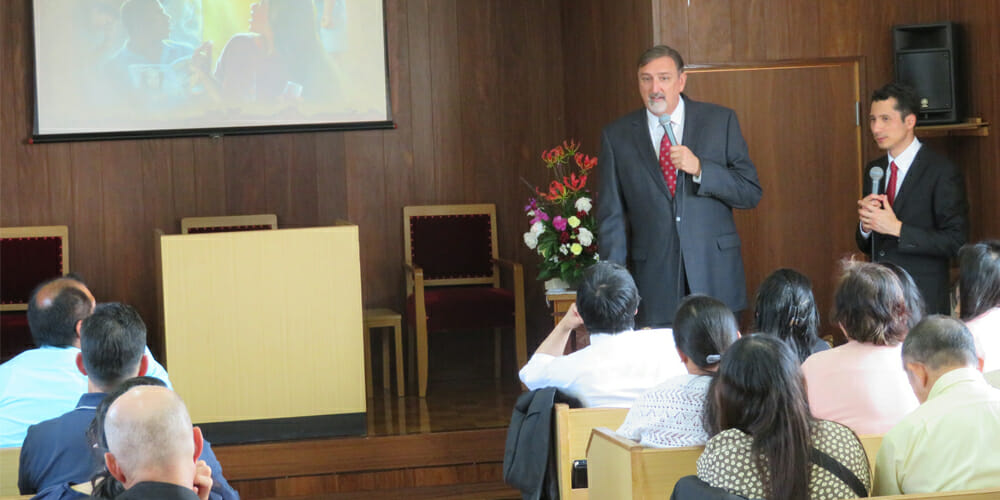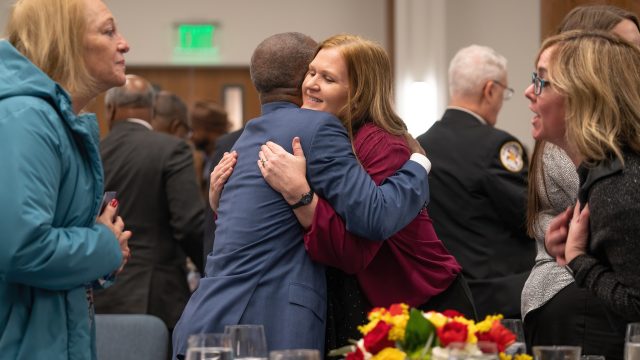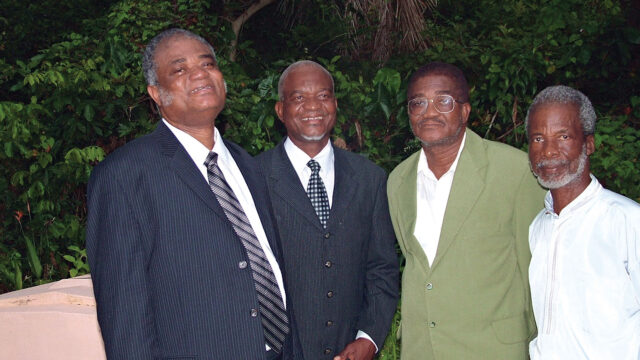In an increasingly diverse Japan, Adventists move to reach people in every language.

The third evangelistic meeting of the day is about to start at the Kariya International Seventh-day Adventist Church, about four hours southwest of Tokyo, Japan. It is a sunny and balmy Spring afternoon, and a gentle breeze runs across the open windows of the second-floor sanctuary.
Guest speaker Robert Folkenberg Jr. looks as fresh as ever, even though this will be his third sermon of the day. He is scheduled to preach twelve in nine days, as part of the “Power of Hope” series.
Before Folkenberg starts, however, local church pastor Roger Ueno has an announcement to make.
“Would you be so kind to group according to the language of your choice?”, he tells the members and visitors who crowd the narrow building.
A Babel of Languages
At worship time a few hours before, Folkenberg had opted to preach in Spanish with someone translating his message into Japanese. Now, just a few minutes before the 2 pm meeting, it was settled he will preach in English with consecutive translation into Portuguese. Those who do not feel comfortable with either of the two languages can still find a designated corner in the sanctuary where one volunteer will translate Folkenberg’s message into Spanish, and yet another one into Japanese.
It is nothing out of the ordinary for this increasingly diverse congregation, which also enlists Tagalog as a fifth language.
“Besides Japan, our members come from Brazil, Perú, the Philippines, and several other countries,” explains one of the congregation’s elders to Adventist Review. “And membership is growing along the lines of ever-increasing diversity.”
Folkenberg, who is the president of the Chinese Union Mission of the Seventh-day Adventist Church based in Hong Kong, seems a perfect fit to lead the International Church evangelistic meetings. As an American who spent years working in Central America, he speaks flawless accent-free Spanish. He also speaks fluent Chinese, even though so far, he quips, his Chinese has not been of any help to understand Japanese better.
He knows, however, how to move swiftly among languages and cultures. On the rare occasions his translator into Portuguese stumbles, he is ready to assist him by switching and rephrasing his last statement in Spanish.
At the International Church, members sing hymns and spiritual songs in various languages, often at the same time.
“I invite you to sing to the Lord in the language of your choice,” song leader and the pastor’s wife Miho Ueno says. Miho herself is a perfect example of Japan’s Adventist diversity. Born in Japan to a Japanese-Brazilian mixed couple, she lived in both countries and also studied in the United States. Ten months ago, she married Pastor Ueno, a Brazilian with a Japanese grandmother who’s been in Japan for years and got his theology training in the Philippines.
“Language and cultural barriers are not barriers here,” she says.
A Homogeneous Society?
Experts usually agree Japan is, in many senses, one of the most homogeneous societies in the world. It is a millennial culture, with a distinct land, language, and traditions. On top of that, decades of strict immigration and naturalization laws have set the nation mostly apart from the multiculturalism so prevalent in scores of other Western nations.
For decades, the Seventh-day Adventist Church, which has been present in Japan for over 100 years now, was no exception. But as some Japanese-speaking church members grow older and the replacement rate lags, “immigrant congregations” are stepping up.
“Brazilian and Filipino churches are growing steadily,” Ueno says. “New groups are popping up all over.”
Spanish-speaking congregations are also making progress. In Isesaki, an hour and a half northwest from Tokyo, several Adventist Peruvian families began worshipping together.
“They are giving Bible studies and preparing their children for baptism,” said Northern Asia-Pacific Division (NSD) treasurer German Lust, who is leading in a weekend of harvest evangelistic meetings at the Isesaki congregation. “They are actively involved in the life of the church.”
And Hispanic groups are sprouting even in the most non-traditional places, such as Okinawa, the island located a two-hour flight south of Tokyo where the Adventist Church has several churches, schools, and a hospital.
NSD Ministerial Association secretary Ron Clouzet is already there to conduct evangelistic meetings. “I’ll be working on nightly meetings in an attempt to establish the first Okinawa Spanish group,” he tells Adventist Review.
From All Nations, One
At the same time, it seems differentiation across ethnic and cultural lines is not always so clear-cut in Japan. Many “international” members grew up in families where more than one language and culture — even more than one religion — were common. At the Kariya Church, several Brazilian members are half-Japanese, as they proudly explain. One of them, Brazilian-born Edmilson Moraes Kazumi, shares that he grew up in a home that combined religious elements from Catholicism, Protestantism, and Buddhism. “For me, it was completely normal,” says Moraes, who was baptized into the Adventist Church in 2012.
On the other hand, at the Tokyo International Seventh-day Adventist Church (TIC), a couple of Ghanaian men add a distinct flavor to the local Adventist tradition. After more than two decades in Japan and with Japanese wives and kids, they are one of the faces of the next generation of Japanese Adventists.
Greater cultural diversity can also be a powerful tool for mission, as church members attending international congregations acknowledge. “We can reach out to colleagues and acquaintances with a similar background,” explains Precy Colarina, a deaconess at TIC who immigrated to Japan from the Philippines more than two decades ago. “And we are doing just that.”
An increasing cultural diversity, however, also means a new set of challenges, some members say. In one case, members of an immigrant population grew so much in number that started to stifle the Japanese-speaking members of the local church. Recently, immigrant members decided to move to a new facility, and now both congregations are thriving.
All in all, however, leaders say that greater cultural mobility has been positive for Adventist congregations across Japan, and many church members are doing their best to make sure churches are welcoming and inviting to people from all backgrounds.
“No matter your origin and your language, you are welcome here,” a Kariya church member says. “We are the family of God.”








